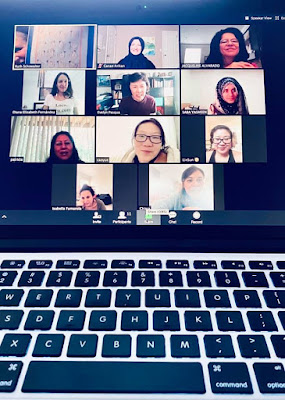Why Teach Improv in the ESL Classroom: The Expert and the Interpreter
Why teach improvisation in the ESL classroom? I combine both typical improvisation activities and my expertise in InterPlay, which is an active creative improvisational system that unlocks the wisdom of the body, allows the trained educator to do the following: -tap students’ creativity -implement students’ personal material -request a different level of student investment which can be powerful and playful. -involve students in the creative process which is stimulating and health promoting. -allow students to respond to information immediately (current issues, interests, and concerns) -impact students’ lives beyond the classroom by building confidence and personal sense of power and providing skills to deal with the unexpected Here, in this activity, "The Expert and the Interpreter," international students are engaged in listening to each other - really listening. They are asked to read and attempt to understand the body language of the experts who are speaking in their native language. Then the interpreter - a student who does not speak the expert's language - is responsible for making up an explanation of what the expert says. However, the interpreter can use a combination of "educated guesses" and imagination, something that can result in humorous outcomes. Especially when the students who comprise the audience use their imaginations to ask the expert unexpected questions that lead to unexpected behaviors.
In the photo above, the students chose a topic from current events - The Corona Virus. They decided the "expert" from Vietnam (standing right)would be a disease specialist studying how to stop the corona virus and she would speak in Vietnamese. Standing left, a student from China, was to explain her self-introduction and answers to the audience's questions. In addition to activating their imaginations and responding to current events, the students discover that they understand quite a bit just from the expert's nonverbal communication. Even the expert was surprised at how closely aligned the interpreter's explanations were with what she said! It is the magic art of communication and play in action.
In this photo, the expert (standing right), speaks in Chinese explaining his expertise as a belly dancer. The interpreter, an Arabic speaker, explains in English. She took an activist position on women's rights and spoke about the expert's desire to close the gap between men and women through his belly dancing. The expert, in turn, was willing to dance when one of his classmate's requested it. Because the topic is so different from anything both students might do, the activity required both of them and their audience to practice some rules of improvisation:
1) Yes, and...Say yes (agree to imagine being a belly dancer), and (to keep adding ideas about belly dancing to support his expertise).
2) Listen to the interpreter and agree (yes) with what she's saying (and)build on her ideas.
3) Takes risks when moving into unknown territories and not being stopped by not knowing what to say.
4) Make your partner look good. In this activity, everyone supports what is said and done. The expert accepts the audience's questions. The expert and listener accept the interpreter's explanations. The audience shows appreciation for the belly dancer's dance.
5) Have fun!
I base my classroom instruction on the following four concepts:
Concept #1 EXPERIENTIAL.I know that students learn from doing, so I transform my classroom into a community of people connecting and making meaningful friendships, using improvisational forms and principles. While students are engaging in activities of “doing and being,” they expand their abilities to communicate effectively while deepening their connection to themselves and to others.
Concept #2 KINESTHETIC. Movement engages students in experiencing a fuller sense of themselves. After more than two decades of teaching students ensconced in their desks, I had an epiphany! I needed to involve the “whole” person – not just the mind – but the body and heart. Freeing them from their seated positions, encumbered by books, pens, papers, jackets, backpacks, I invited my students to experiment with expanding their range of movement beyond their desks. I encourage them to find ways to use their physicality to express themselves in ways they find satisfying and successfully communicates their intentions.
Concept #3 NONJUDGMENTAL. Yes! I encourage students to take risks and make mistakes during our improvisational activities because doing so involves them in a process that leads to discovery, self-knowledge, and success. Critiques of “good and bad” are banished in order to achieve an environment for exploration and risk taking. Instead, we are searching for choices through a range of experiences and unknowing.
Concept #4 REFLECTIVE. Quiet moments of reflection are important after kinesthetic activities, engagement with others, and jumping into the unknown. When students stop and “notice” how they feel physically and emotionally and what they are thinking, something powerful takes place – self-discovery, connection to others and development of “new” knowledge. When these reflections are shared with classmates, it allows students to connect in a different and perhaps deeper way than discussing just the content provided by the activities.






Comments
Post a Comment